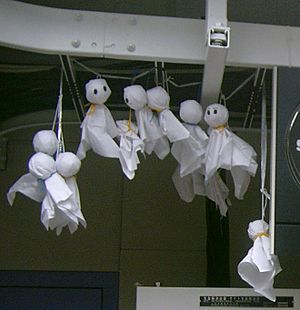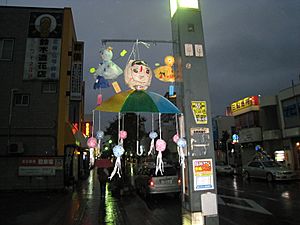Teru teru bōzu facts for kids
A teru teru bōzu (Japanese: てるてる坊主 or 照る照る坊主, literally "shine shine monk") is a small, traditional handmade doll. It is usually made from white paper or cloth. Japanese people, especially farmers long ago, started hanging them outside their windows. These dolls look quite similar to ghost dolls, like those made for Halloween. This special charm is believed to have magical powers. It is supposed to bring good weather and stop or prevent rainy days.
The word teru is a Japanese verb that means "to shine," like the sun. A bōzu is a Buddhist monk. Today, bōzu can also be a friendly way to talk about little boys.
Contents
What is a Teru Teru Bōzu?
A teru teru bōzu is a type of talisman. A talisman is an object believed to have magical powers. People use these dolls to wish for sunny weather. They are a very common superstition in Japan. This means many people believe in their power, even if it's not scientifically proven.
History of the Dolls
Teru teru bōzu dolls became popular a long time ago. This was during the Edo period in Japan. This period lasted from 1603 to 1868. City people, especially children, loved making them. They would make the dolls the day before they wanted good weather. Then, they would chant a little song. The song asked the "fine-weather priest" to make the next day sunny.
How People Use Them Today
Today, children still make teru teru bōzu dolls. They often use tissue paper or cotton for the dolls. They hang them from a window when they want sunny weather. This is common before a school picnic or a special outdoor event.
Traditionally, if the weather turned out well, people would thank the dolls. They would pour a little bit of sake (a Japanese drink) over them. Then, they would let the dolls float away in a river. This was a way to show gratitude.
There is also a special way to use the doll to ask for rain. If you hang a teru teru bōzu upside-down, it acts as a prayer for rain instead of sunshine.
The Teru Teru Bōzu Song
There is a very famous children's song, called a warabe uta, about teru teru bōzu. Kyoson Asahara wrote the words for the song. Shinpei Nakayama composed the music. This popular song was first released in 1921.
See also
 In Spanish: Teru teru bōzu para niños
In Spanish: Teru teru bōzu para niños



